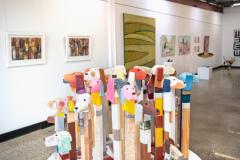
On Saturday 8 August FireWorks Gallery hosted an artists’ talk for our two current exhibitions; Joanne Currie Nalingu, River Marks and Alick Sweet, Isle of Dogs. The talks were scheduled to be chaired by Lynne Seear, Manager for Arts in Health, Children’s Health Queensland. Unfortunately, this did not eventuate.
Artist Joanne Currie was admitted to hospital for tests (Joanne suffered an aneurism late last year) and Lynne was quarantined after having to take a COVID test (a precaution taken for those working in the health sector). As we navigate this challenging year we can realise that we are often just taking it one day at a time and learning new ways to manage our spaces and enable discussions.
Very kindly, Lynne was able to offer a message via email to be shared. FireWorks director Michael Eather took over the role of facilitator and spoke on Joanne’s behalf with artist Alick Sweet about each Artist’s practice but also the role of art outside the gallery environment.
A Message from Lynne Seear, Manager Arts In Health
So ... strange and difficult times. I had to have my second COVID test this morning, and that means I can’t be with you today. Unlike my family and friends in Melbourne, I can be pretty confident I don’t have the virus because thankfully there are so few cases in Queensland. But because I work in a hospital, I’m obliged to get tested even with the mildest of symptoms.
It’s not a big ask for me, the next 2-3 days in comfortable quarantine at home, but it’s a reminder that this is a precarious moment for so many, and it feels even more important in these circumstances that we come together to discuss the role that art should and does play when we are trying to make sense of and overcome grief, fear, anxiety and change.
Ten years ago, I left a great job at QAGOMA because I knew I had one more big professional change in me and I wanted to find out what that might be. Not long after, I was asked to become involved in curating an art collection for the new children’s hospital being designed and built in South Brisbane. This felt more than serendipitous. During the 16 years I worked at the Queensland Art Gallery, David (my Husband) and I lost both our children. They were treated and eventually passed away at the old Royal Children’s Hospital at Herston. We became way too familiar with that place, during dozens of hospitalisations, the longest lasting four interminable months. Many times, I would leave my job at the Gallery and my office overlooking the river, and drive straight to the hospital to spend the night in a bedside recliner, the contrast between the two environments as stark as it could possibly be.
I thought a great deal during those years about what could have made the experience easier to endure, and I didn’t come up with much, except that I began to be interested in what a transformed clinical environment might look like, one that felt safer and easier to occupy, more human-centred, more comfortable, more beautiful, more designed to feel part of the world and not separate from it. And I knew that art could and should be a part of that transformation.
Luckily, I wasn’t the only one wondering about how the connection between creativity and wellbeing might influence healthcare. By the time I joined the Arts in Health sector, there was a whole discipline dedicated to it.
I’ve now spent a decade immersed in that field, bringing art and music and literature and dance and theatre to the heart of healthcare. I’ve worked with clinicians, bureaucrats, architects, designers, artists, project managers and builders - all of them determined to create a new kind of hospital, and I’ve been privileged to be involved in some of the most innovative health infrastructure projects in Australia.
I was supposed to be here today because Joanne and Alick are two of the artists I’ve worked with most recently, through Michael.
Joanne’s work has been acquired and commissioned for the new hospital that has been built on the site of the old Royal Children’s, STARS, due to open later this year. Of course it’s particularly poignant that I get to participate in this project, and I’m so thrilled that Joanne’s work will be included.
At the Queensland Children’s Hospital, we have a magnificent display of Alick’s carved planes and sea creatures in our Gait Lab, where children with movement disorders and disabilities are treated and assessed.
One of the things that I say to people who ask me what art can accomplish within a hospital is to ask them in return, ‘If art shouldn’t be here, then where should it be?’. This is where it is most needed, with the vulnerable, and the sick, and their families and carers.
But the fact is, that in these spaces, art has to pay for itself by doing a job beyond beauty. It has to have meaning, and to tell stories that are specific to the healthcare context. We make sense of our lives through stories. Regardless of our different backgrounds and perspectives, stories have the power to bind us. The thing we need most of all when we are unwell is to feel connected to others.
At STARS, Joanne’s paintings and shields will tell stories of resilience and determination to patients trying to reclaim their lives after serious illness. At the children’s hospital, clinicians tell stories about fish and turtles and crocodiles as they encourage children to learn to walk alongside the dramatic installation of Alick’s sculptures leading them, step by step, from one end of a corridor to another.
I hope you all enjoy the show today.




